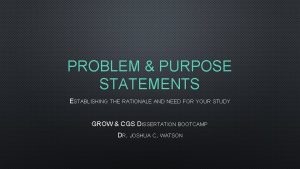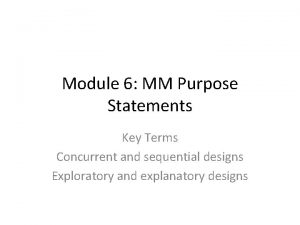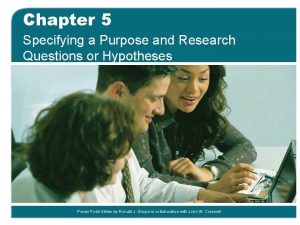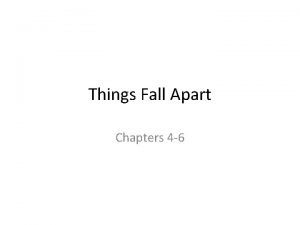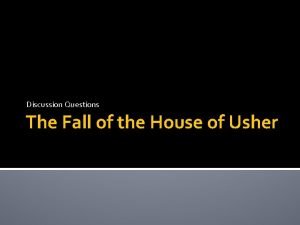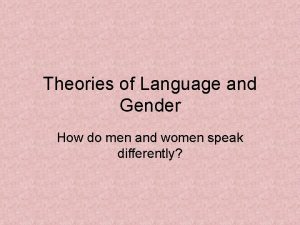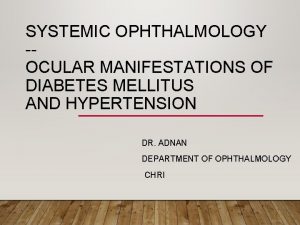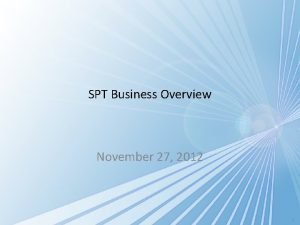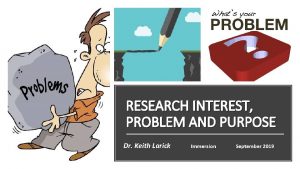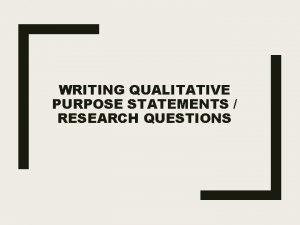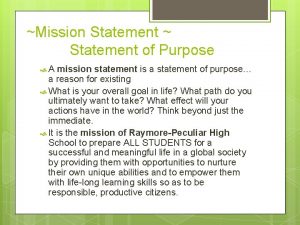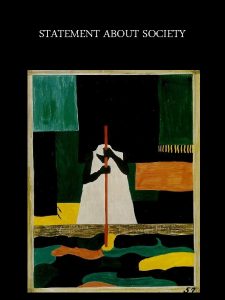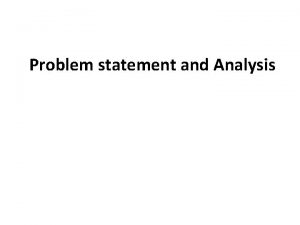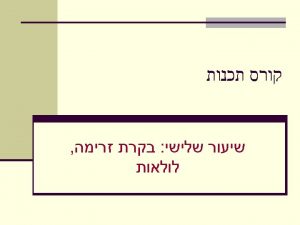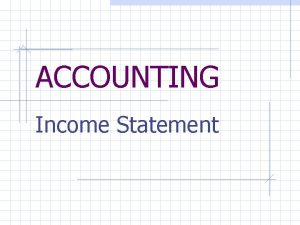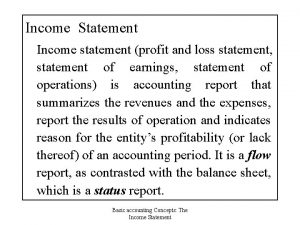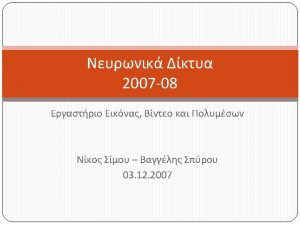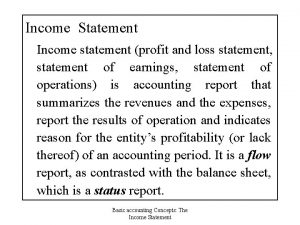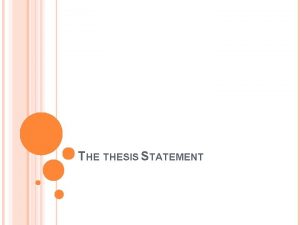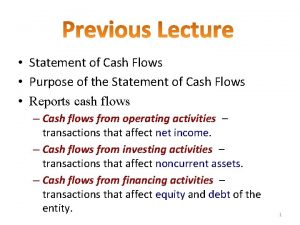PURPOSE STATEMENT RESEARCH QUESTIONS Dr Keith Larick Fall































- Slides: 31

PURPOSE STATEMENT RESEARCH QUESTIONS Dr. Keith Larick Fall Immersion 2018

• Review & refresh of material covered at June Immersion • Write out the research problem you intend to pursue • Generate a draft purpose statement • Generate a list of variables being addressed in the purpose statement to serve as direction for library research • Generate draft research questions • Small group discussions with faculty

A purpose statement is a declarative sentence which summarizes the specific topic and goals of the research. The purpose statement is derived from the problem statement.

The problem is something to be solved. The purpose addresses a specific aspect of the problem.

TOPIC, PROBLEM, PURPOSE AND QUESTIONS Topic Eating disorders Research Problem Literature Purpose Statement Specific Research Questions Line of Logic General Teenagers and eating disorders Teen peer pressure and bulimia What role does peer pressure play in the development of bulimia among teenagers?

Problems or situations that involve logical thinking call for structure, for relationships between facts, and for chains of reasoning that “make sense. ”

Broad Topic Research Topics – Questions – Purpose Narrowed Topic Focused Topic Research Question Women’s Health Women and cancer Women smokers and breast cancer Is there an association between smoking and breast cancer risk? Computer Games Computer game violence & children Violence in Sports Violence in baseball Violence in professional baseball How does violence in computer games affect children? What is the effect of violence in professional baseball on high school baseball players? Problem

Handout RESEARCH TOPICS – QUESTIONS – PURPOSE BROAD TOPIC NARROWED TOPIC FOCUSED TOPIC RESEARCH QUESTION PURPOSE Why are you interested in this topic? What do you know about this topic? Is there a line of logic in this topic? Is each piece connected to the next? Is this a researchable topic?

15 Minute Activity – Checking Research Topic Logic 1. State the topic of interest. 2. Write some of the things you know that draw your interest. 3. Write down what you don’t know that interests you in this topic. 4. Narrow the topic in steps 2, 3 & 4. 5. State your topic as a “master” research question. 6. Share you topic with a partner. (2) 7. Ask for feedback on the line of logic, feasibility of the research and will it make a contribution.

Purpose Statement

QUALITATIVE AND QUANTITATIVE PURPOSE STATEMENTS Qualitative purpose statements contain infinitives and verbs related to the emergent, non-predictive nature of Qualitative research such as: to describe, to discover, to develop, or to explore. Quantitative purpose statements use infinitives and verbs that indicated prediction and comparison such as: to examine the relationship, to compare, to test, to identify, to examine the correlation between. (Creswell, 2003)

An effective statement of purpose should be: • • Specific and precise – not general or broad Concise – one or two sentences Clear – not vague or ambiguous Goal-oriented – stated in terms of desired outcomes Some common introductory phrases for purpose statements include: The purpose of this mixed methods study was…. . The purpose of this case study was twofold: to _____ and _____ The purpose of this phenomenological study was to describe __

Purpose Statement Template Dissertation Handbook

QUANTITATIVE PURPOSE STATEMENT TEMPLATE The purpose of this __________(experimental, single-subject, casual comparative, correlational, quantitative, descriptive, mixed method) study was to _______(Identify, Describe, Examine, Compare) the __________(central focus of the study – independent variable – control variable) for ____(the unit of analysis: Group, Groups, Site(s)).

QUALTITATIVE PURPOSE STATEMENTS The purpose of this _____________ (strategy of inquiry, such as biographical, phenomenological, grounded theory, ethnographic, historical, case study) was to ________ (understand, describe, develop, discover) the ___________(central phenomenon/focus) for the _______________ (unit of analysis/participants) such as the individual, groups, organization). Patton – page 132 -233 – Variety in Qualitative Inquiry

EXAMPLE 1 The purpose of this phenomenological study was to investigate individual experiences of African Americans, who overcame obstacles and attained the rank of chief of police. • • Family background Educational history Mentorship Socioeconomic status Peer relations Leadership experience and philosophy Racial and cultural issues Politics of law enforcement

EXAMPLE 2 The purpose of this quantitative correlational study was to determine the relationship between teacher job satisfaction and the teacher-perceived leadership traits of principals within K-12 unified school districts in Orange County California. Satisfaction theory Teacher satisfaction Retention Leadership & employee satisfaction Leadership trait theories

EXAMPLE 3 The purpose of this qualitative study is to explore absenteeism from nonmandatory synchronous sessions in the virtual learning environment, Wimba Classroom, by undergraduate and graduate students in online courses at three California State Universities in southern California. Central Question: What are students’ attitudes regarding nonmandatory synchronous sessions in Wimba at a southern university? Sub-questions: 1. What are students’ reasons for attending nonmandatory synchronous sessions in Wimba? 2. What are students’ reasons for not attending nonmandatory synchronous sessions in Wimba? 3. What actions could the university or its instructors take that would motivate students to increase their attendance at nonmandatory synchronous online sessions?

Words of Importance QUANTIATIVE Identify Measure Compare Examine Correlation Relationship Degree Relate Influence Impact Effect Cause Generates data that is measurable requiring mathematical analysis should relate to data in Takes the form of numerical quantities such as measurements or counts. QUALITATIVE Describe Explore Probe Understand Discover Learn Investigate How What Generates data requiring identification of themes, Observations. Requires coding, Frequently tables, etc.

DRAFTING THE PURPOSE STATEMENT 1. Based on the problem and focused question developed earlier, draft your purpose statement. Use the purpose statement template. (15 minutes) 2. Present your draft purpose statement to your partner. (10 minutes) 3. Ask for feedback using the Purpose statement checklist. HANDOUTS

Purpose Checklist 1. Key identifier words are used to signal the reader, such as “The purpose of this (qualitative/quantitative/mixed method/(methodology) is to ……” The methodology needs to be appropriate for this purpose. 2. The central phenomena being explored are explicated. 3. The statement is clear and precise. Does not contain sweeping generalizations or pronouncements. 4. Is a researchable topic or issue. 5. Avoids use of value-laden words and terms. 6. Identifies key concepts and terms. 7. The variables, if quantitative, are clearly defined. 8. The intent of the study (to analyze, determine, identify, explore, describe…. ) is delineated with words that reflect higher order thinking skills. 9. The issue or phenomenon is clear. 10. Articulation of the study boundaries or parameters. 11. The participants of the study (sample and/or population are mentioned. 12. The setting of the study is explained.


QUANTITATIVE RESEARCH QUESTIONS There is no "one best way" to structure a quantitative research question. However, to create a well-structured quantitative research question, we recommend an approach that is based on four steps: (1) Choosing the type of quantitative research question you are trying to create (i. e. , descriptive, comparative or relationshipbased); (2) Identifying the different types of variables you are trying to measure, manipulate and/or control, as well as any groups you may be interested in; (3) Selecting the appropriate structure for the chosen type of quantitative research question, based on the variables and/or groups involved; and (4) Writing out the problem or issues you are trying to address in the form of a complete research question. Descriptive, comparative and relationship-based research questions. http: //dissertation. laerd. com/how-to-structure-quantitative-research-questions. php

QUALITATIVE RESEARCH QUESTIONS Use good qualitative wording for these questions. • Begin with words such as “how” or “what” • Tell the reader what you are attempting to “discover, ” “generate, ” “explore, ” “identify, ” or “describe” • Ask “what happened? ” to help craft your description • Ask “what was the meaning to people of what happened? ” to understand your results • Ask “what happened over time? ” to explore the process Avoid words such as: relate, influence, impact, effect, cause 1. Cresswell. J. W. (2007). Qualitative inquiry & research design: Choosing among five approaches. Thousand Oaks: Sage Publications. 2. Creswell, J. W. , & Plano Clark, V. Principles of qualitative research: Designing a qualitative study. You can download the entire document here.

Purpose Statement The purpose of this mixed methods grounded theory study was to explore differences in perceptions of school connectedness among Long Term English Language Learner (LTELL) students and Redesignated Fluent English Proficient (RFEP) students in a comprehensive high school setting. The study also sought to determine whether or not there is a relationship between English language acquisition and perceptions of school connectedness among these two English Learner (EL) subgroups.

Research Questions 1. Do Long Term English Language Learner (LTELL) students have different perceptions of school connectedness than Redesignated Fluent English Proficient (RFEP) students? 2. What are the differences in perceptions of school connectedness between LTELL and RFEP students? 3. What is the relationship between perceptions of school connectedness and language acquisition among LTELL and RFEP students?

RESEARCH QUESTIONS Purpose Statement Research Questions Write your Purpose Statement Draft 2 -3 Research Questions

ALIGNMENT The purpose of this explanatory mixed-method study was to identify and describe the unique needs of twins enrolled in center-based preschools and the program practices that the experts and practitioners believe to be important to address those needs. ALIGNMENT • Twins • Unique needs PURPOSE QUANT/QUAL RQ SURVEY QUESTIONS • Center-based preschools 1. 1, 2 • Program practices 2. 5 • Experts 3. 8 • Practitioners 4. 1, 11 5. 14, 19 INTERVIEW QUESTIONS 4, 5, 6 7 3 1, 2 9, 10

VARIABLES A variable is a concept or abstract idea that can be described in measurable terms. In research, this term refers to the measurable characteristics, qualities, traits, or attributes of a particular individual, object, or situation being studied. Variables are things that we measure, control, or manipulate in research. They differ in many respects, most notably in the role they are given in our research and in the type of measures that can be applied to them. Variables are properties or characteristics of some event, object, or person that can take on different values or amounts

VARIABLES The purpose of this explanatory mixed-method study was to identify and describe the unique needs of twins enrolled in center-based preschools and the program practices that the experts and practitioners believe to be important to address those needs. Research Questions This study sought answers to the following research questions: 1. What do experts identify as the unique needs of twins enrolled in center-based preschools? 2. What program practices specific to twins enrolled in center-based preschools do experts and practitioners believe would be most important to meet their needs? 3. Are their differences in perceptions of the experts and practitioners regarding program practices that meet the unique needs of twins enrolled in center-based preschools?

 Purpose of the study example
Purpose of the study example Research purpose example
Research purpose example Problem
Problem Purpose statement in research example
Purpose statement in research example A research statement example
A research statement example Purpose of research questions
Purpose of research questions Thesis statement things fall apart
Thesis statement things fall apart Things fall apart author's purpose
Things fall apart author's purpose Ambiguity in the fall of the house of usher
Ambiguity in the fall of the house of usher Contain in a sentence
Contain in a sentence Specific purpose statements
Specific purpose statements Things fall apart summary chapter 6
Things fall apart summary chapter 6 Things fall apart chapter 15 questions and answers
Things fall apart chapter 15 questions and answers The fall of the house of usher discussion questions
The fall of the house of usher discussion questions Things fall apart ch 17 summary
Things fall apart ch 17 summary Things fall apart socratic seminar questions
Things fall apart socratic seminar questions Keith mukami
Keith mukami George keith and john shuttleworth
George keith and john shuttleworth Keith blakely md
Keith blakely md Scheie classification
Scheie classification Keith legoy
Keith legoy Keith foord
Keith foord Keith bryant
Keith bryant Keith shubert
Keith shubert Keith haring retrospect meaning
Keith haring retrospect meaning Charles and keith shoe
Charles and keith shoe Venous nipping
Venous nipping Keith hohn
Keith hohn Pastor keith johnson
Pastor keith johnson Keith bjorge
Keith bjorge Meaning
Meaning Erin keith unr
Erin keith unr


